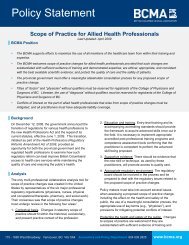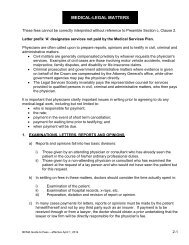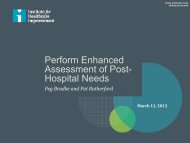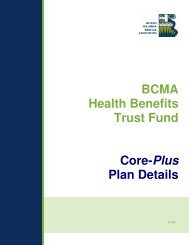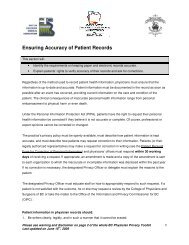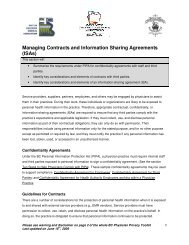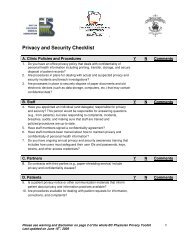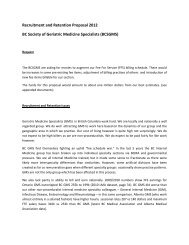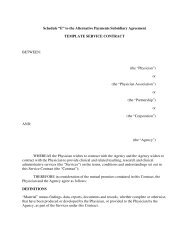Doctors Today and Tomorrow - British Columbia Medical Association
Doctors Today and Tomorrow - British Columbia Medical Association
Doctors Today and Tomorrow - British Columbia Medical Association
Create successful ePaper yourself
Turn your PDF publications into a flip-book with our unique Google optimized e-Paper software.
• Evaluating health authorities’ physician resource planning targets <strong>and</strong> strategies annually <strong>and</strong> recommending<br />
changes as required.<br />
• Identifying short- <strong>and</strong> long-term physician workforce priorities <strong>and</strong> strategies to obtain priority physician<br />
resources.<br />
It is clear that the multiple <strong>and</strong> sometimes conflicting interests of the various stakeholder organizations engaged in<br />
physician workforce planning need to be balanced against efforts to improve physician resource planning. Issues of<br />
political interests, territorial <strong>and</strong> professional advocacy, <strong>and</strong> financial accountability all become very real in planning<br />
physician resources. Nevertheless, the productive interplay between different stakeholders needs to be fostered<br />
through a structured, collaborative approach early in the process. Each stakeholder has a unique role in workforce<br />
planning, <strong>and</strong> underst<strong>and</strong>ing physician resource needs through these various perspectives will allow for better<br />
outcomes.<br />
Recommendation 2<br />
The Physician Workforce Planning Committee should develop a provincial analytical<br />
framework for needs-based physician resource planning.<br />
A provincial analytical framework for translating population health needs into physician requirements is needed.<br />
Physician workforce planning is generally based on estimating the effects of demographic change on the supply of<br />
<strong>and</strong> dem<strong>and</strong> for physician services. However, this practice assumes that the relationships between age <strong>and</strong> needs<br />
<strong>and</strong> between the numbers of physicians <strong>and</strong> the quantity of services provided are independent of other factors <strong>and</strong><br />
constant over time. An extended analytical framework that builds on traditional forecasting methods (e.g., supply<br />
based, utilization based) <strong>and</strong> incorporates health care needs <strong>and</strong> service provision can be composed of four distinct<br />
elements (Birch et al., 2009):<br />
• Demography: The size <strong>and</strong> age distribution of the population being served.<br />
• Epidemiology: The different levels of need independent of the demographic mix of the population.<br />
• Level of care: The amount of services required to address a given level of need.<br />
• Productivity: The average amount of services produced per provider.<br />
In the traditional approach, by overlooking the influence of epidemiology, level of care, <strong>and</strong> productivity, each of<br />
these elements is implicitly assumed to be equal across communities <strong>and</strong> constant over time. By incorporating these<br />
elements into an analytical framework, any changes in these variables can be accommodated into the planning<br />
process. Moreover, each of these three variables can be influenced to varying extents by carefully considering their<br />
determinants. For instance, in the case of epidemiology, policies that prioritize prevention might be used to reduce the<br />
<strong>Doctors</strong> <strong>Today</strong> <strong>and</strong> <strong>Tomorrow</strong> – Recommendations 25



